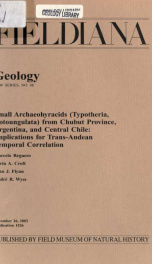The Tinguiririca Fauna of the Andean Main Range of central Chile is remarkable for its abundant and diverse archaeohyracids. This study recognizes four relatively large-bodied species from the Tinguiririca Fauna, two of which are new. Together with two previously described small-bodied forms, the total of six species makes the archaeohyracid assemblage from Tinguiririca the most diverse known, representing the co-occurrence of at least 40% of all archaeohyracid species in a single fauna. The two new archaeohyracids are referred to Archaeotypotherium (A. tinguiriricaense and A. pattersoni), for which a revised diagnosis also is presented. The revision synonymizes the Argentine taxa Archaeohyrax propheticus, Archaeotypotherium transitum, and Archaeohyrax ("Bryanpattersonia") nesodontoides under Archaeotypotherium propheticus (new combination). Four specimens from central Chile, including three mandibular fragments and one partial upper dental series, are referred to the two existing species of Pseudhyrax. The upper dental series is one of the best examples known for the taxon, and is referred to Pseudhyrax cf. P. eutrachytheroides. Based on a metric study of Pseudhyrax specimens from Argentina, one of the Chilean mandibles is referred to Pseudhyrax eutrachytheroides, one to Pseudhyrax strangulatus, and a third to Pseudhyrax sp. indet. Analysis of a large sample of Archaeohyrax specimens from Salla, Bolivia, provides the basis for interpreting wear-related metric variation in archaeohyracid tooth dimensions. It demonstrates that most cheek teeth decrease in length and increase in width through increasing wear, although upper and lower third molars are exceptions. Owing to the dramatic metric and morphologic differences between worn and unworn archaeohyracid teeth, care should be taken when interpreting the systematic significance of metric differences among specimens of different wear states. A preliminary phylogenetic analysis suggests that taxa traditionally included in the Archaeohyracidae do not form a monophyletic group exclusive of Hegetotheriidae and that a comprehensive review of the names associated with major clades of typothere notoungulates is needed Includes bibliographical references (p. 36-38) The Tinguiririca Fauna of the Andean Main Range of central Chile is remarkable for its abundant and diverse archaeohyracids. This study recognizes four relatively large-bodied species from the Tinguiririca Fauna, two of which are new. Together with two previously described small-bodied forms, the total of six species makes the archaeohyracid assemblage from Tinguiririca the most diverse known, representing the co-occurrence of at least 40% of all archaeohyracid species in a single fauna. The two new archaeohyracids are referred to Archaeotypotherium (A. tinguiriricaense and A. pattersoni), for which a revised diagnosis also is presented. The revision synonymizes the Argentine taxa Archaeohyrax propheticus, Archaeotypotherium transitum, and Archaeohyrax ("Bryanpattersonia") nesodontoides under Archaeotypotherium propheticus (new combination). Four specimens from central Chile, including three mandibular fragments and one partial upper dental series, are referred to the two existing species of Pseudhyrax. The upper dental series is one of the best examples known for the taxon, and is referred to Pseudhyrax cf. P. eutrachytheroides. Based on a metric study of Pseudhyrax specimens from Argentina, one of the Chilean mandibles is referred to Pseudhyrax eutrachytheroides, one to Pseudhyrax strangulatus, and a third to Pseudhyrax sp. indet. Analysis of a large sample of Archaeohyrax specimens from Salla, Bolivia, provides the basis for interpreting wear-related metric variation in archaeohyracid tooth dimensions. It demonstrates that most cheek teeth decrease in length and increase in width through increasing wear, although upper and lower third molars are exceptions. Owing to the dramatic metric and morphologic differences between worn and unworn archaeohyracid teeth, care should be taken when interpreting the systematic significance of metric differences among specimens of different wear states. A preliminary phylogenetic analysis suggests that taxa traditionally included in the Archaeohyracidae do not form a monophyletic group exclusive of Hegetotheriidae and that a comprehensive review of the names associated with major clades of typothere notoungulates is needed Fieldiana series has been published as Geological Series by Field Columbian Museum (1895-1909) and Field Museum of Natural History (1909-1943), and as Fieldiana: Geology by Chicago Natural History Museum (1945-1966) and Field Museum of Natural History (1966-1978). Fieldiana Geology New Series No. 1 began June 29, 1979



